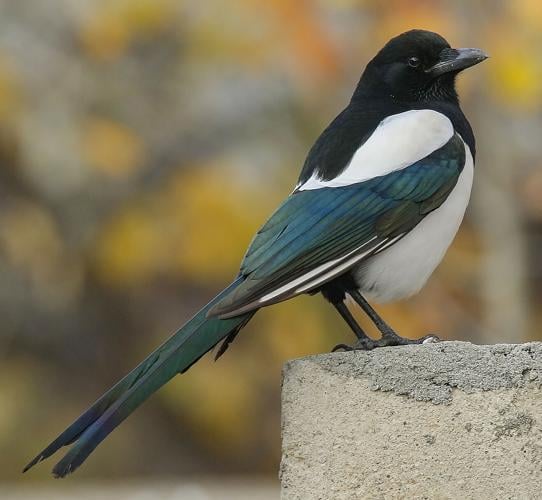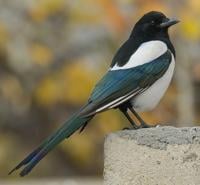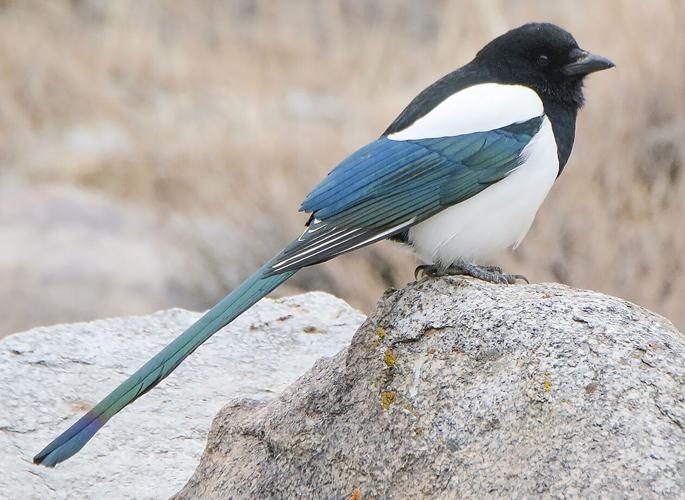Often when I meet people who are visiting Colorado or relocating from the eastern U.S., they ask “What is that beautiful black and white bird with the long tail?” My typical shrugging reply is, “Oh that’s just a magpie.”
While common in the West, the Black-billed Magpie is basically absent in the East. Growing up in Denver they had a bad reputation in our yard area. Like crows and ravens, magpies follow a pugnacious and predatory lifestyle, bullying smaller birds and even raiding nests to eat eggs and nestlings. However, they are indeed beautiful and unmistakeable, with their striking black and white body pattern and streaming ornamental tail. Magpies are the only bird in our area with a tail longer than the body. In proper lighting, their wings and tail even display an iridescent quality.
Magpies are in the corvid group. Most corvid bodies are not very colorful, with variations of white, black and gray. They are social, aggressive and truly omnivorous, eating a wide variety of plants and animals with their large sturdy beaks. Corvids are also considered the most intelligent of birds with great memories and even the ability to mimic sounds. Other corvids that you are likely to see in Teller County include Common Raven, American Crow, Canada Jay, Steller’s Jay and Clark’s Nutcracker.
Magpies are year-round residents and typically travel in pairs or small flocks, sometimes gathering in large groups. On rare occasions I have observed flocks of up to 40, and they often gather around dead animals, cleaning up roadkill along streets and highways. Typical of corvids, magpie calls are loud and harsh, with a nasally quality, but during the winter their chatter can liven up the dead winter landscape. The sexes appear similar and magpies are a bit smaller than a crow. Note that juveniles may have shorter tails.
The varied habitat of the magpie includes open fields, conifers, forest edges, farms and ranches, riparian and pinyon-juniper woodlands, shrublands and urban areas. They are less common in dense forest and above 9,000 feet, but will range above treeline up to 13,000 feet. Magpies like to stroll along the ground in search of myriad food items — mostly insects, but also other invertebrates, carrion, small vertebrates, eggs, fruit, nuts and seeds.
In winter their round and bulky stick nests in trees and shrubs are more exposed, often the size of a basketball. On occasions they reuse nests in subsequent breeding seasons. Some research suggests that intolerance to heat and humidity is why magpies have not spread to the eastern U.S. Common and widespread throughout Colorado, even non-birders tend to be familiar with the Black-billed Magpie.
Notable reports from the Woodland Park Yard Area in January:
Hairy Woodpecker — territorial drumming on Jan. 19
Northern Flicker — one on Jan. 5
Black-billed Magpie — a few around most of the time, 8 on Jan. 21
White-breasted Nuthatch — one or two around most of the time
Dark-eyed Junco subspecies: All 5 subspecies (including resident Gray-headed) on Jan. 16; Pink-sided and White-winged — a few around some of the time; Oregon and Slate-colored — one each around some of the time.
Evening Grosbeak — a couple of sightings
Cassin’s Finch — a few around some of the time, 10 on Jan. 25, 12 on Jan. 30, singing on Feb. 1
Pine Siskin — a few around most of the time, 10 on Jan. 30, 32 on Feb. 1!
House Finch — singing on Jan. 24
House Sparrow — a pair around some of the time
Joe LaFleur studied wildlife biology and communications at Colorado State University and is the creator of “Better Birdwatching,” a DVD series on North American birds. Contact him with questions and feedback at joe@betterbirdwatching.com.








 Your Privacy Choices
Your Privacy Choices